No products in the cart.
NEWS
Grow Sweet, Juicy Strawberries in Your Own Hanging Basket
If you dream of fresh strawberries but feel limited by garden space, don’t despair. A strawberry hanging basket presents an elegant and practical solution. With the right approach and consistent care, a planter suspended from your porch or balcony can become a source of delicious fruit all summer long. The sight of vibrant red berries trailing alongside lush green foliage spilling from the pot adds a beautiful touch to any outdoor living area. Growing strawberries in containers like hanging baskets is a straightforward and rewarding way to maximize your edible gardening potential within a small footprint. Let’s delve into the essentials to get you started on cultivating your own hanging berry patch.
Why Choose a Strawberry Hanging Basket?
Cultivating strawberries in hanging baskets offers several distinct advantages. It’s a remarkably simple yet effective method to enjoy homegrown fruit, especially beneficial for those with limited ground space, such as on patios, balconies, or small yards.
Elevating the plants inherently helps to deter common garden pests that travel along the ground and significantly reduces the risk of soil-borne diseases impacting the leaves and fruit. Placing the basket correctly can even help protect ripening berries from some ground-dwelling wildlife.
Furthermore, strawberries naturally produce runners, which can rapidly spread and become invasive in traditional garden beds. Keeping them contained within a hanging basket maintains a neat and tidy growing area.
However, successful hanging basket strawberry cultivation requires careful attention to several factors: ensuring adequate sunlight, using appropriate soil, providing consistent nutrition, and diligent watering are all key. For many climates, container-grown strawberries may not survive harsh winters unless given special protection, so plan on treating them as annuals or implementing overwintering steps. Additionally, choosing the right type of strawberry, specifically a day-neutral or everbearing variety, is essential for continuous or multiple harvests within the first growing season.
Selecting the Best Strawberry Varieties for Hanging Baskets
Choosing the appropriate strawberry variety is crucial for achieving a thriving hanging basket display laden with fruit. Varieties known as June-bearing types are generally less suitable for annual container growing because they require significant effort for runner management and often need blooms pinched in the first year to strengthen for future yields, which isn’t ideal for harvesting in the first season.
For hanging baskets focused on yielding fruit within the first year, prioritize varieties that fruit continuously or produce multiple harvests per season. You can typically purchase these as live plants from garden centers or order dormant bare-root plants. Look for varieties specifically recommended for containers or hanging baskets.
Day-Neutral Varieties
These are excellent choices for maximizing fruit production throughout the season, as they bloom and fruit whenever temperatures are between roughly 35°F and 90°F (1.7°C to 32°C), though production may pause during extreme heat.
Day-neutral types naturally produce fewer runners than other types, making them tidier for containers. If you do see runners, it’s generally best practice to remove them to redirect the plant’s energy into producing more delicious fruit.
- Popular Day-Neutral Varieties for Baskets: Albion, Seascape, Cabrillo, Everest, San Andreas, Monterey, Tristar, Tribute, Mara des Bois, Evie.
Everbearing Varieties
Similar to day-neutral types, everbearing strawberries produce fewer runners than June-bearing varieties. While they fruit multiple times, they typically offer two main harvests per growing season rather than continuous fruiting.
- Good Everbearing Varieties for Baskets: Ozark Beauty, Quinalt, Fort Laramie, Ogallala, Pink Panda (known for attractive pink flowers).
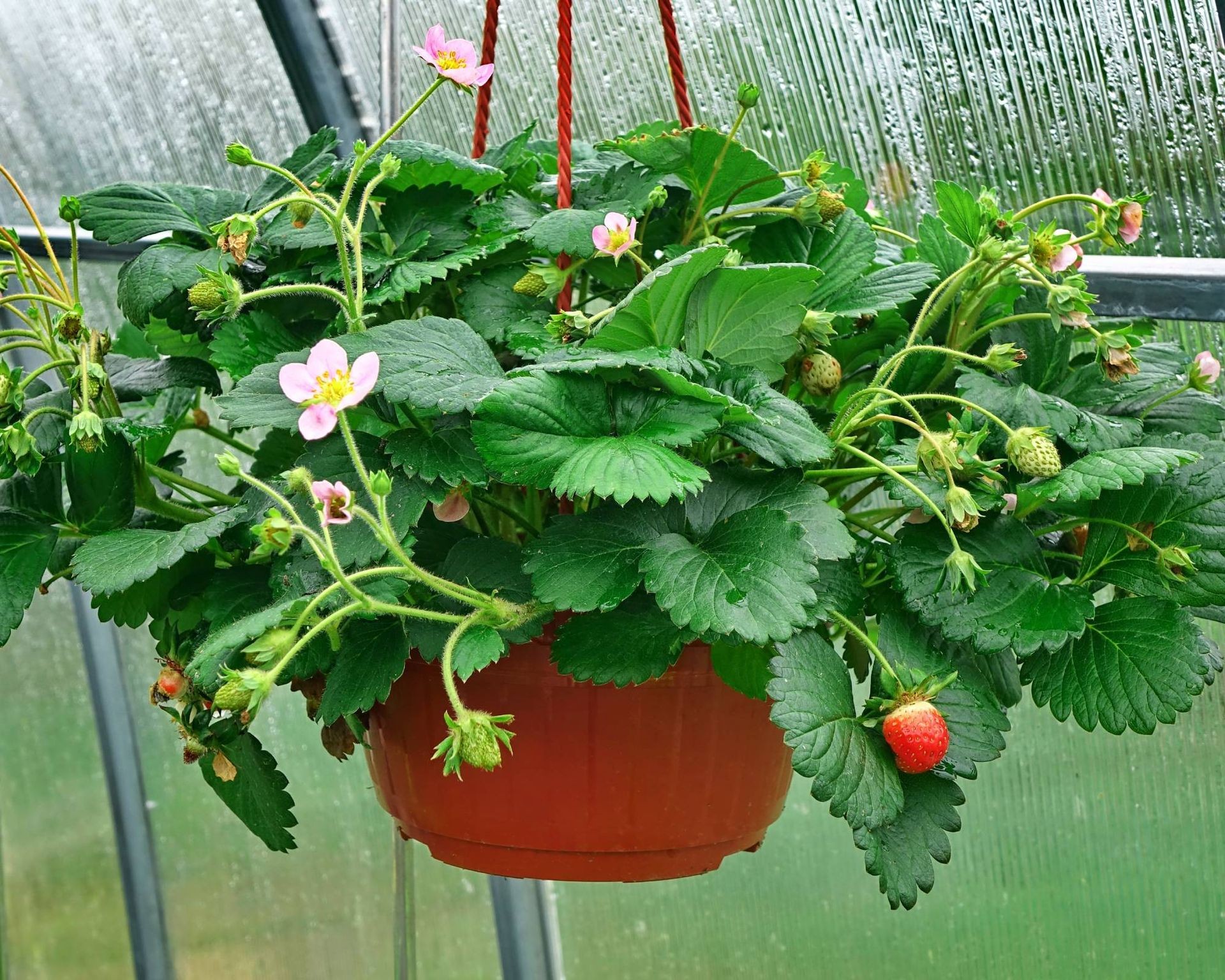 Everbearing strawberry plants in a hanging basket featuring vibrant pink flowers and ripening fruit
Everbearing strawberry plants in a hanging basket featuring vibrant pink flowers and ripening fruit
Alpine Varieties
Consider Alpine strawberries (Fragaria vesca) for a slightly different, delightful experience. These plants tend to be more compact and produce smaller, intensely fragrant, and exceptionally sweet berries.
A major advantage is their tolerance for partial shade conditions, making them an excellent choice for locations that don’t receive full sun all day. Alpine varieties typically fruit consistently from spring through fall, offering a steady supply of sweet treats.
- Recommended Alpine Varieties for Baskets: Mignonette, Rugen Improved, Yellow Wonder (distinctive yellow fruit).
Any of these recommended types can create beautiful and productive hanging basket strawberry plants. Look for them at local nurseries or reputable suppliers.
Growing and Caring for Your Hanging Basket Strawberries
Successful strawberry cultivation in hanging baskets involves providing the right conditions and consistent care throughout the season.
Choosing Your Container and Soil
Start with a suitable container. Select a sturdy hanging basket that is large enough, ideally at least 12 inches (30 cm) in width and 8 to 10 inches (20 to 25 cm) deep. This size is important to provide adequate space for the root system to develop and support healthy foliage and fruit production.
Well-draining soil is absolutely critical to prevent waterlogged roots and potential root rot. A high-quality commercial potting mix designed for containers is an excellent choice. You can also create your own blend by combining two parts compost, two parts coco coir (or another peat alternative), and one part perlite or vermiculite to ensure good drainage and aeration.
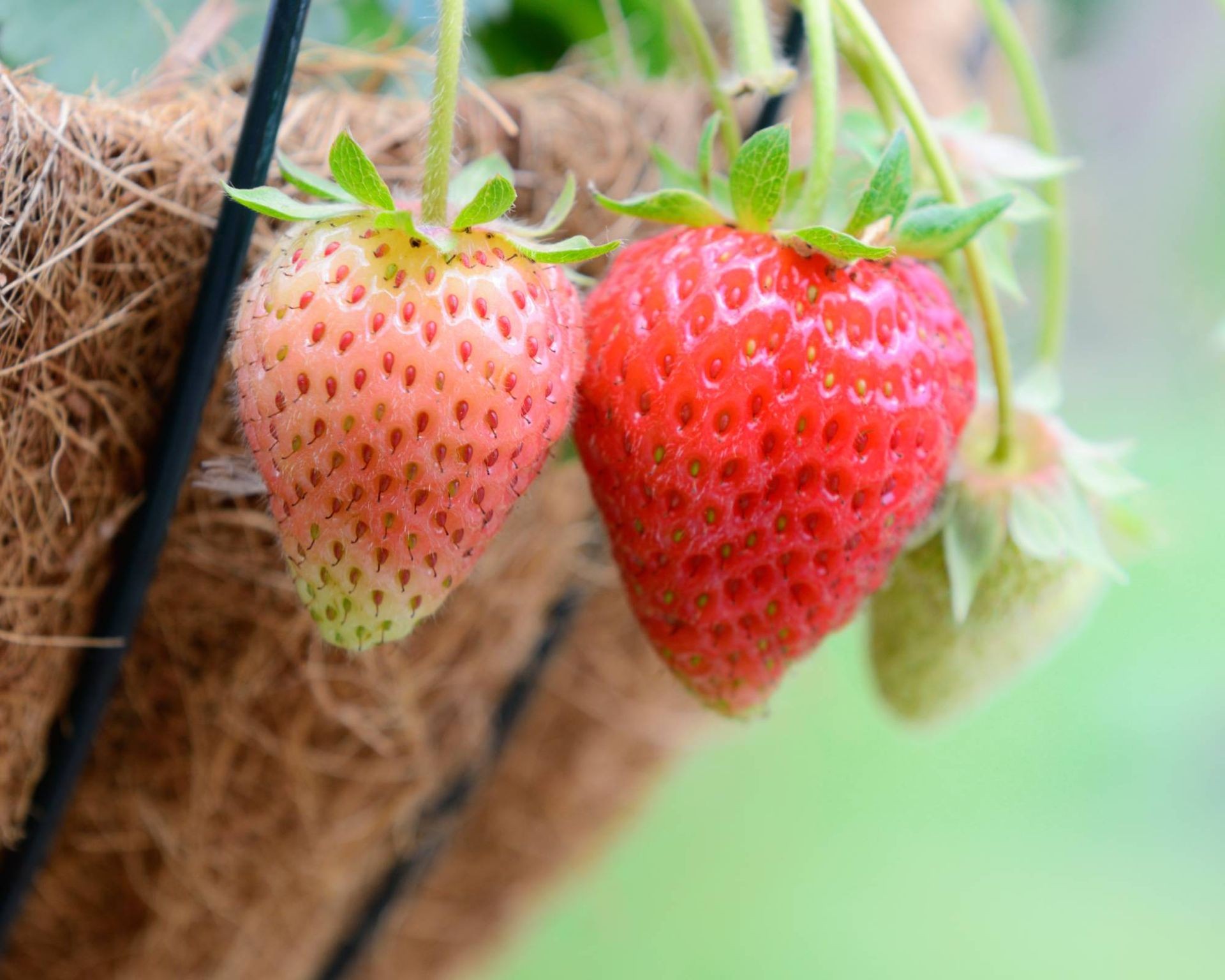 Preparing a wire hanging basket by inserting a natural coco coir liner
Preparing a wire hanging basket by inserting a natural coco coir liner
Planting
The best time to plant your chosen strawberry varieties is typically in early spring after the danger of hard frost has passed. Carefully place the plants in your prepared containers, ensuring the top of the root ball is level with the soil surface. Avoid planting too deeply, as this can lead to crown rot, a common issue.
In a 12 to 14 inch (30 to 36 cm) basket, you can usually fit about four nursery-sized plants. Space them slightly closer together than you might in a garden bed, as they are intended to cascade attractively over the sides of the basket. Keep an eye out for and remove any runners that emerge to help the plant focus its energy on producing fruit.
Placing your hanging baskets near spring-blooming flowers can help attract beneficial pollinators like bees, which are essential for successful fruit set and development.
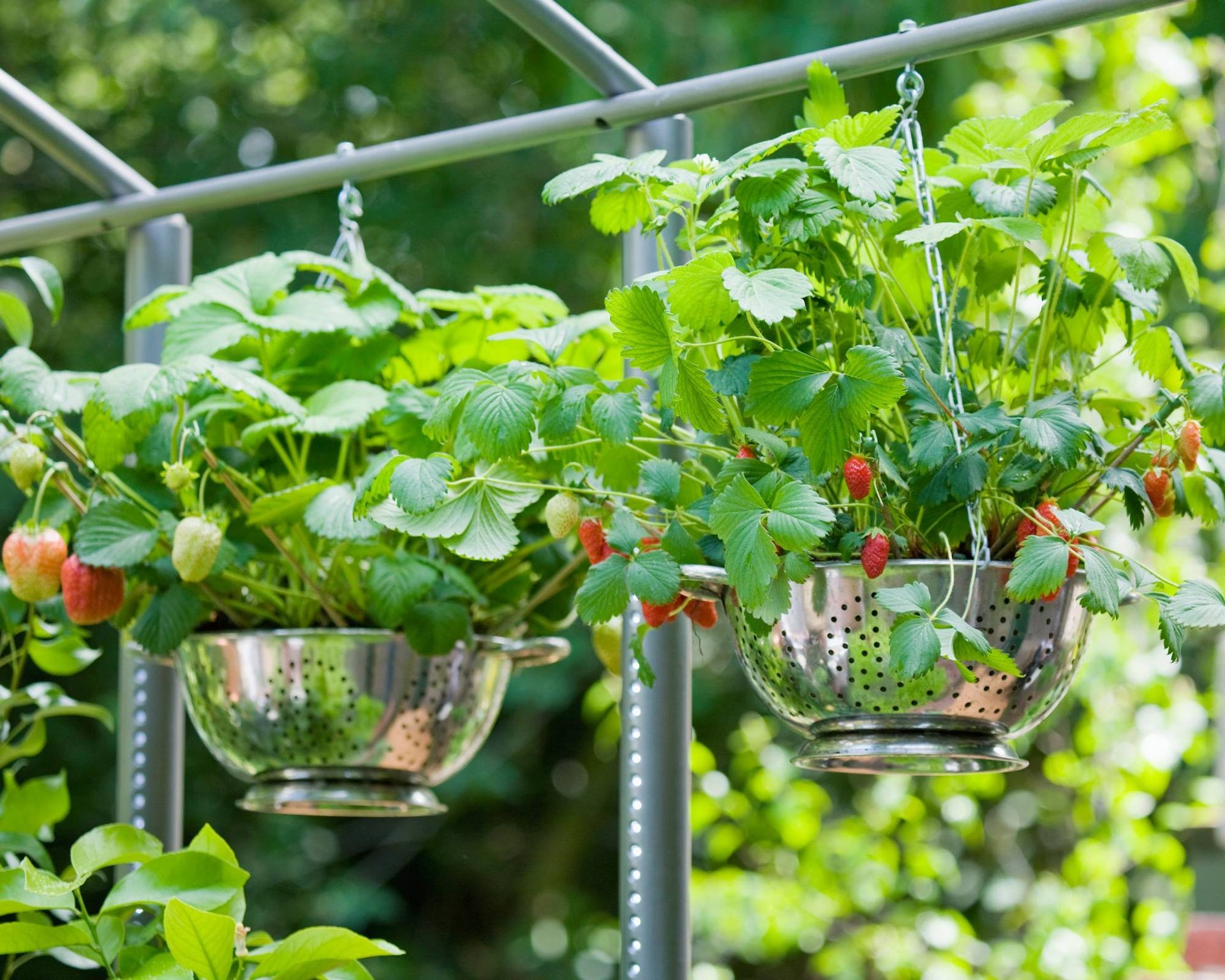 Hanging strawberry plants overflowing from white colander containers
Hanging strawberry plants overflowing from white colander containers
Fertilizing
Strawberries are relatively heavy feeders, especially when grown in the confined space of a container where nutrients can quickly leach out. If your potting mix doesn’t contain a slow-release fertilizer, apply a balanced granular or liquid fertilizer (such as a 16-16-16 or 20-20-20 analysis) shortly after planting, following the product instructions carefully.
Regular feeding is important throughout the growing season. Plan to fertilize your hanging basket strawberries two to three times total, roughly once a month until the plants begin to bloom and set fruit heavily.
Watering & Mulching
Consistent moisture is vital for developing sweet, juicy strawberries, but the soil should never be saturated or waterlogged. The shallow root systems of container plants dry out much faster than those in the ground, so check the soil surface daily. Water thoroughly when the top inch or so feels dry to the touch. In hot or windy weather, you may find yourself needing to water twice a day.
Applying a thin layer of mulch, such as clean straw, around the base of the plants helps to retain soil moisture, regulate soil temperature, and suppress weeds. Be careful to keep the mulch slightly away from the plant’s central crown to prevent moisture buildup and potential rot. Mulching also helps keep ripening fruit off the soil surface, further reducing disease risk. When watering, try to direct the water towards the soil and roots rather than wetting the foliage and developing fruit, which can also contribute to rot.
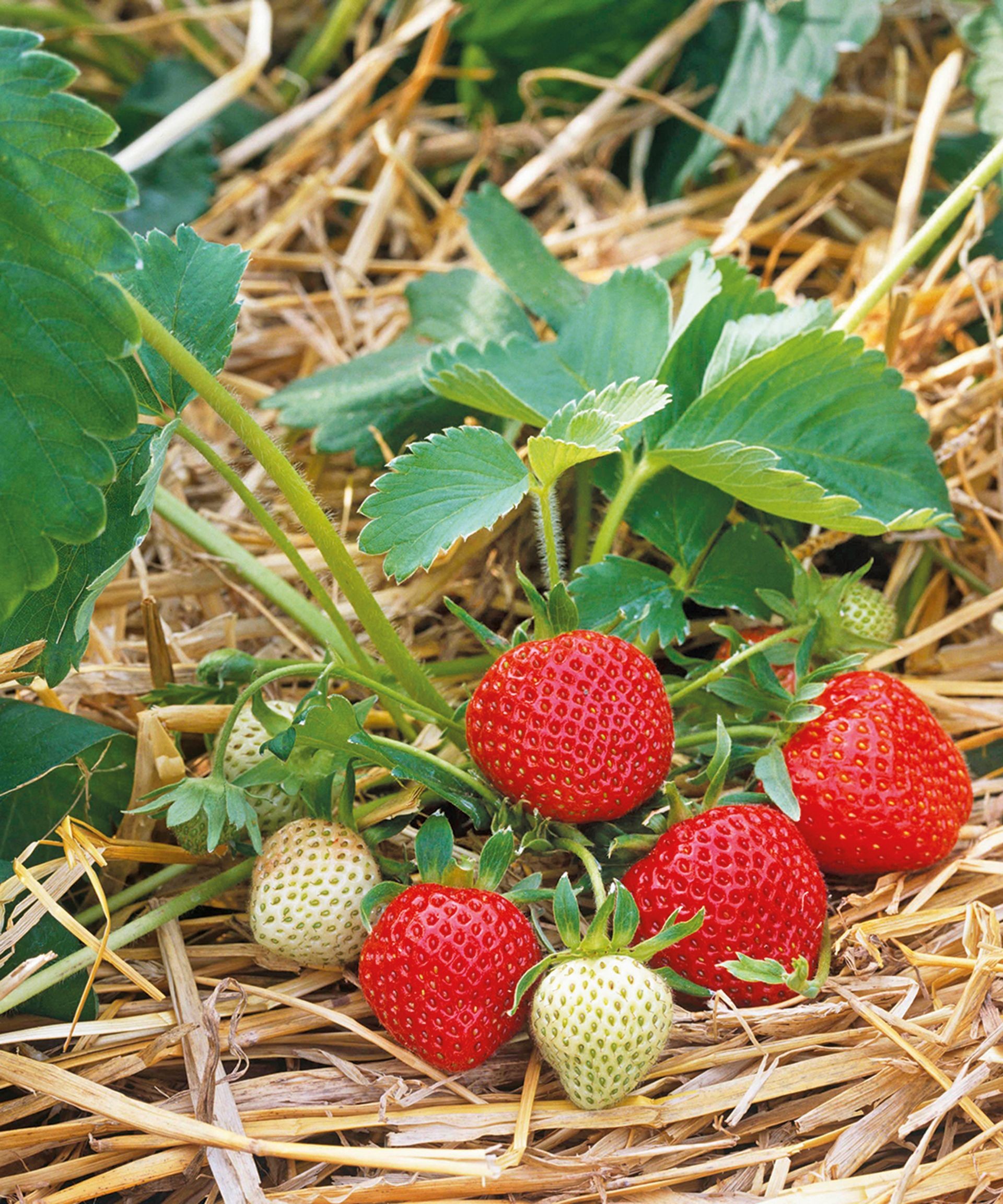 Applying protective straw mulch around strawberry plants in a container garden
Applying protective straw mulch around strawberry plants in a container garden
Managing Pests & Diseases
While hanging baskets offer some natural protection from ground-dwelling pests, it’s important to remain vigilant for potential problems. Watch for common strawberry issues like leaf spot, powdery mildew, and crown rot. Promptly remove and discard any leaves or fruit that show signs of disease to prevent its spread.
Birds are often attracted to ripening berries. A simple and effective solution is to cover your hanging basket with fine netting as the fruit begins to change color to protect your precious harvest from feathered friends.
Harvesting
For optimal fruit production, most hanging strawberry varieties (with the exception of Alpine types, which are more tolerant of partial shade) require at least six to eight hours of full sun daily. Harvest your strawberries when they are completely colored a rich, uniform red.
To help the fruit last longer after picking, it’s best practice to harvest them with the small green cap (calyx) and a short piece of stem still attached. While berries will continue to ripen slightly after being picked, they will generally have the best flavor and sweetness when allowed to ripen fully on the plant before harvesting.
Overwintering & Longevity
To potentially enjoy harvests from the same plants for more than one season, you may need to provide winter protection. Move your hanging strawberry garden to a sheltered area if extreme temperatures, intense heatwaves, heavy rain, or frost are expected. Freezing temperatures can injure or even kill strawberry plants, so bringing containers into a garage, shed, or other protected space in late fall before hard frosts is advisable.
Winterizing your potted strawberries allows the roots to survive, and the plants will resume growth in the spring. Plan to repot them each spring using fresh potting soil to replenish nutrients and provide a good growing medium for the coming season. While plants can remain productive for up to about three years, their vigor and yield may decline over time, and you might consider replacing them with new stock after this period for optimal harvests.
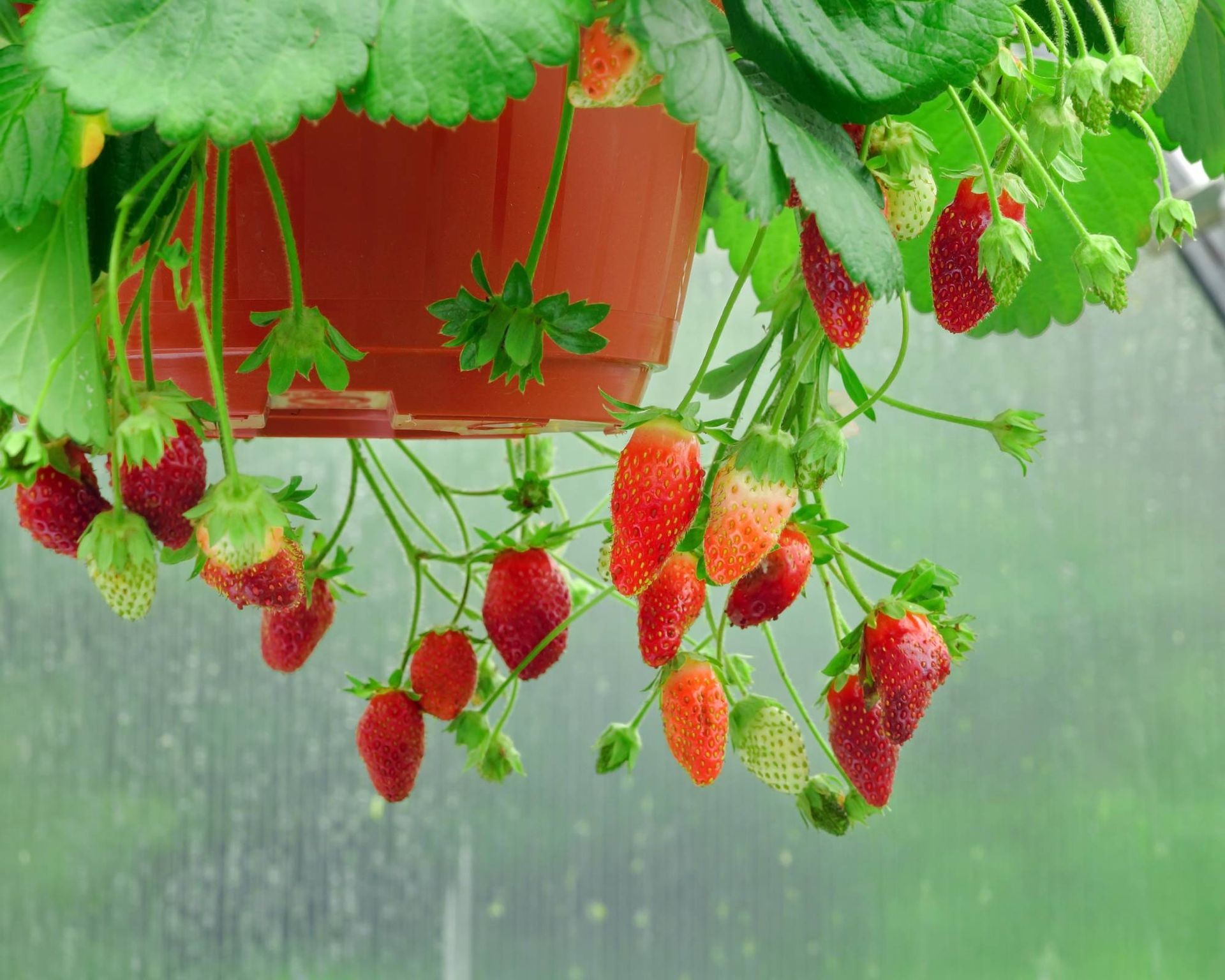 A bountiful hanging basket filled with ripe, delicious red strawberries
A bountiful hanging basket filled with ripe, delicious red strawberries
Conclusion
Growing strawberries in hanging baskets is a wonderfully rewarding way to bring the pleasure of homegrown fruit into your life, even when traditional garden space is at a premium. By selecting suitable varieties and providing consistent care – focusing on adequate light, careful watering, timely fertilization, and vigilant pest management – you can look forward to a beautiful display and a continuous supply of sweet, juicy berries right outside your door. It’s a relatively simple gardening project that delivers significant satisfaction and delicious rewards.
Ready to add the delightful taste of fresh strawberries to your home? Cultivating a strawberry hanging basket is a perfect way to start. We encourage you to explore the possibilities and experience the joy of harvesting your own berries. Discover quality soils and gardening supplies that can support your efforts and share your gardening journey and your delicious, homegrown harvests!



